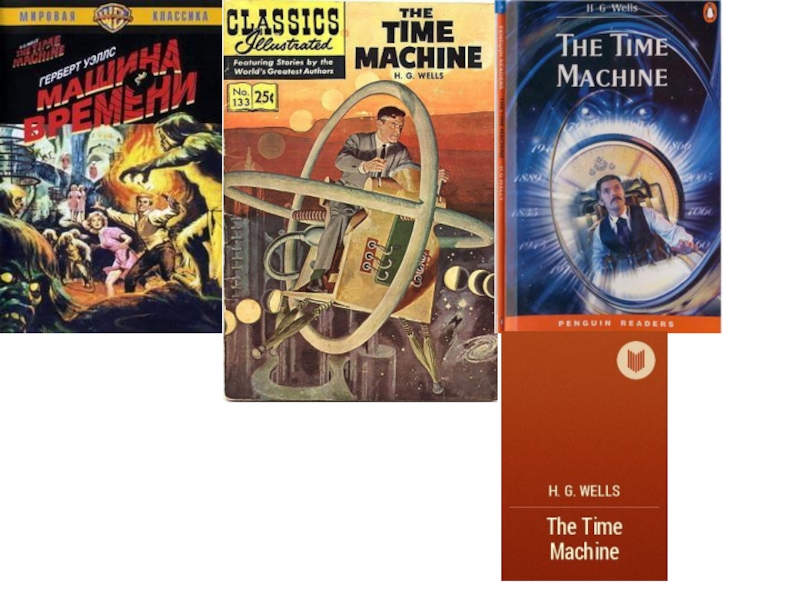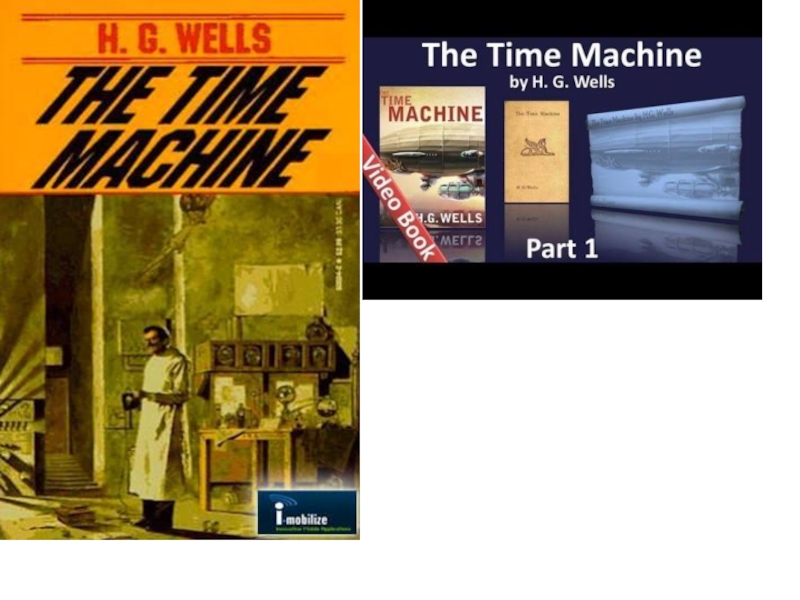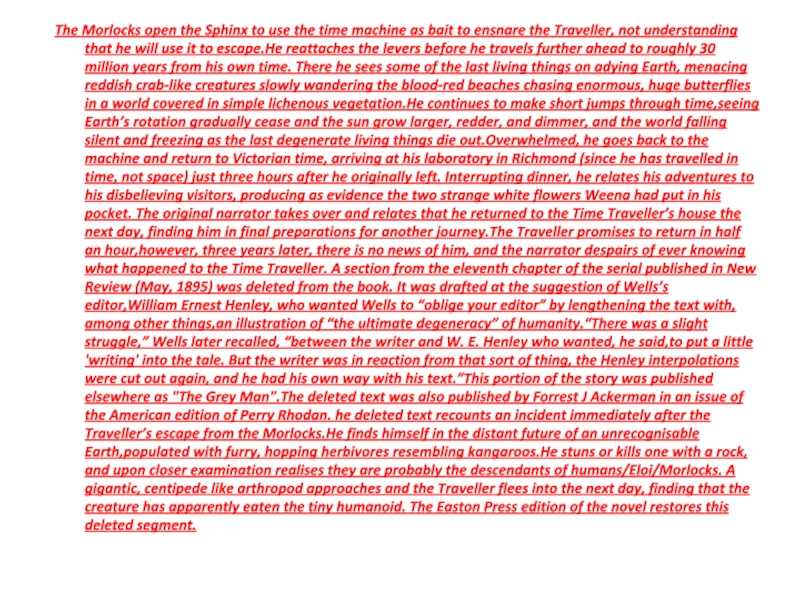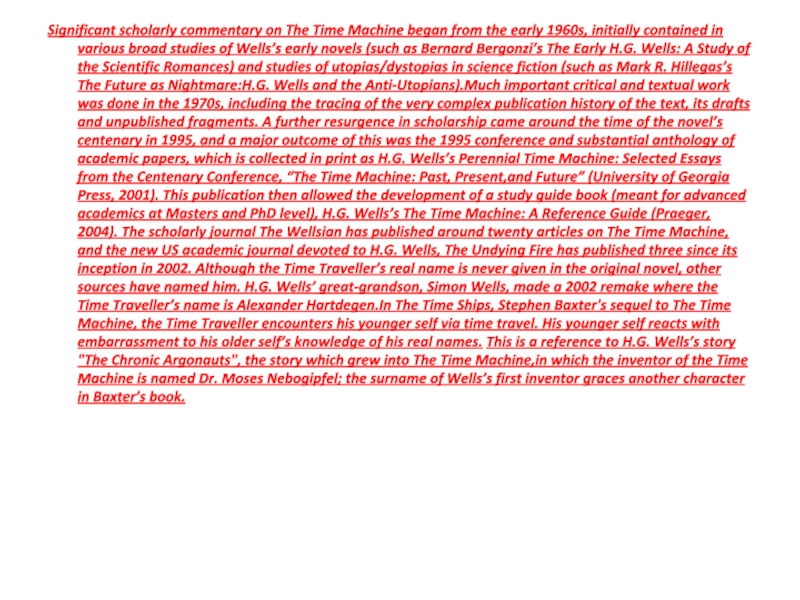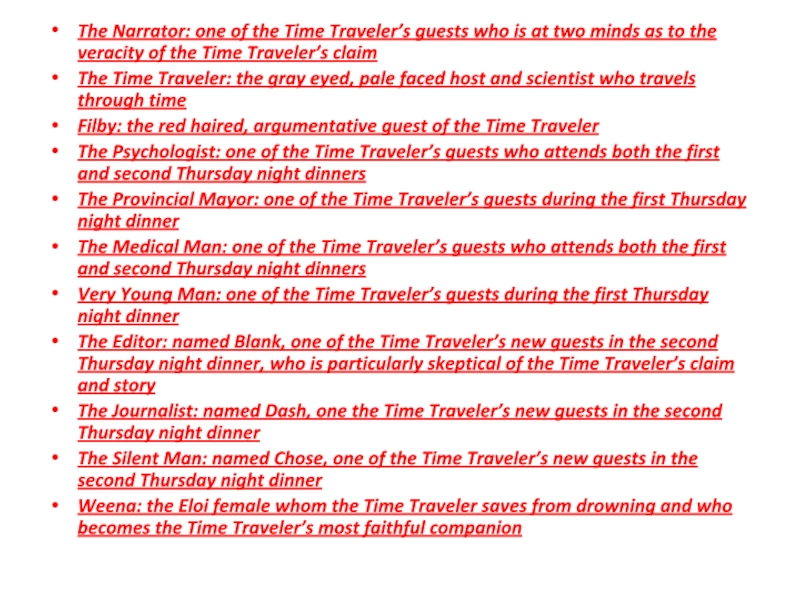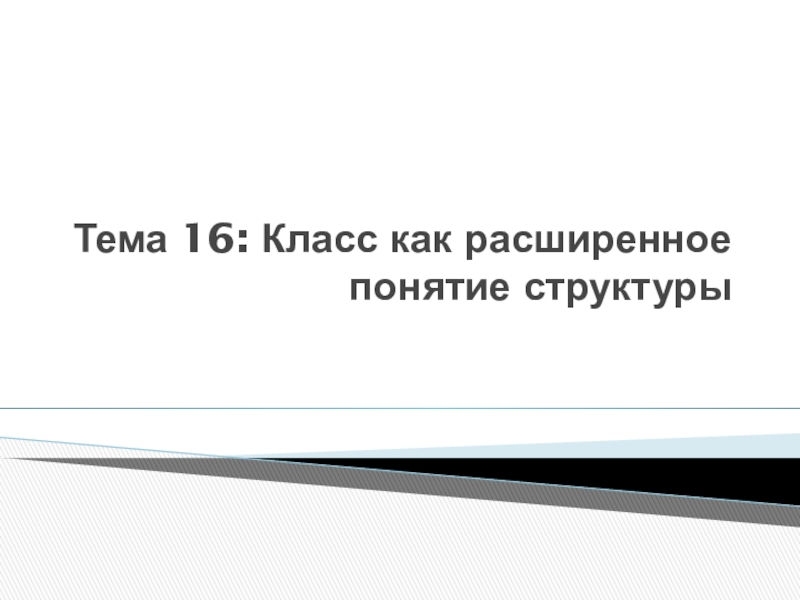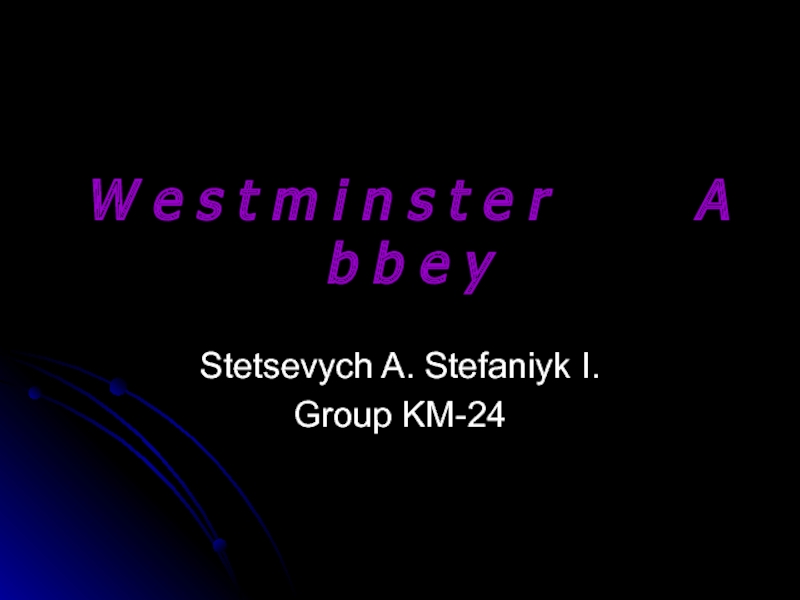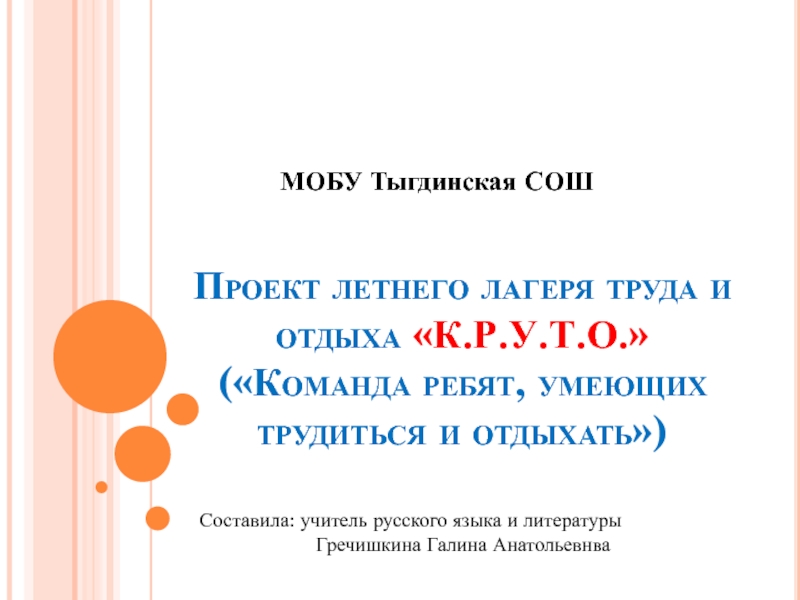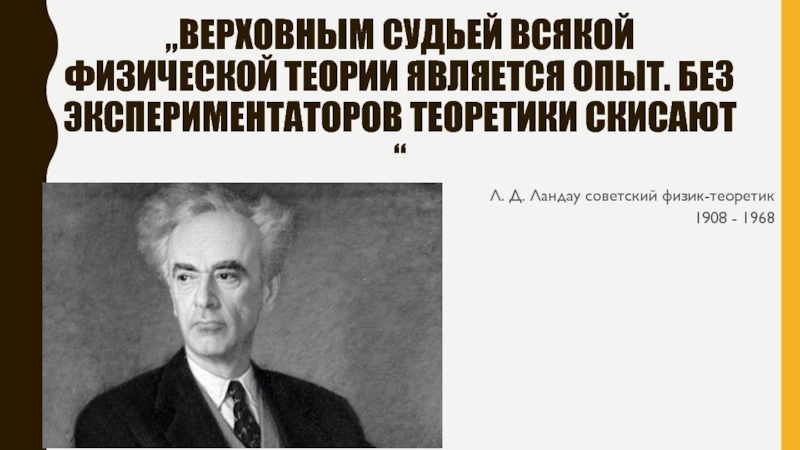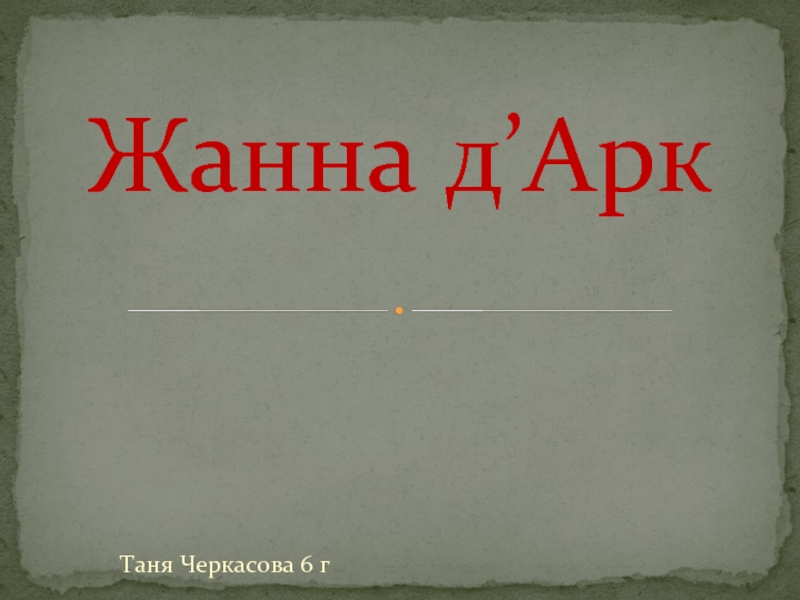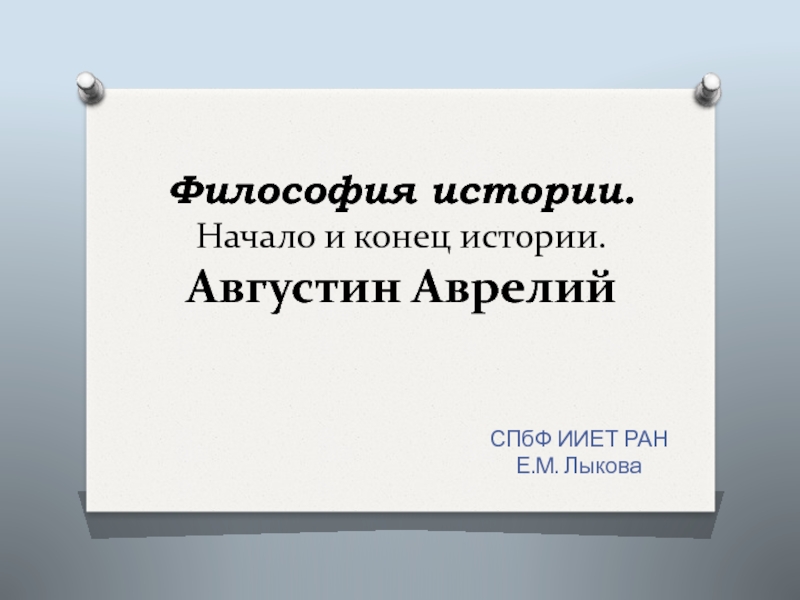Разделы презентаций
- Разное
- Английский язык
- Астрономия
- Алгебра
- Биология
- География
- Геометрия
- Детские презентации
- Информатика
- История
- Литература
- Математика
- Медицина
- Менеджмент
- Музыка
- МХК
- Немецкий язык
- ОБЖ
- Обществознание
- Окружающий мир
- Педагогика
- Русский язык
- Технология
- Физика
- Философия
- Химия
- Шаблоны, картинки для презентаций
- Экология
- Экономика
- Юриспруденция
SATYSHEVA AYALA,FL-48
Содержание
- 1. SATYSHEVA AYALA,FL-48
- 2. Слайд 2
- 3. Слайд 3
- 4. The Time Machine is a science fiction
- 5. In the new narrative,the Time Traveller tests
- 6. The Morlocks open the Sphinx to use
- 7. Significant scholarly commentary on The Time Machine
- 8. The Narrator: one of the Time Traveler’s
- 9. Thanks you for your attention!
- 10. Скачать презентанцию
The Time Machine is a science fiction novel by H. G.Wells, published in 1895. Wells is generally credited with the popularization of the concept of time travel by using a vehicle
Слайды и текст этой презентации
Слайд 4The Time Machine is a science fiction novel by H.
G.Wells, published in 1895. Wells is generally credited with the
popularization of the concept of time travel by using a vehicle that allows an operator to travel purposefully and selectively. The term “time machine”, coined by Wells,is now universally used to refer to such a vehicle. The Time Machine has since been adapted into two feature films of the same name, as well as two television versions, and a large number of comic book adaptations.It has also indirectly inspired many more works of fiction in many media. Wells had considered the notion of time travel before, in a short story titled "The Chronic Argonauts" (1888). his work, published in his college newspaper, was the foundation for The Time Machine.Wells frequently stated that he had thought of using some of this material in a series of articles in the Pall Mall Gazette, until the publisher asked him if he could instead write a serial novel on the same theme. Wells readily agreed and was paid £100 (equal to about £10,000 today) on its publication by Heinemann in 1895, which first published the story in serial form in the January to May numbers of The New Review (newly under the nominal editorship of W. E. Henley). Henry Holt and Company published the first book edition (possibly prepared from a different manuscript)on 7 May 1895; Heinemann published an English edition on 29 May.These two editions are different textually and are commonly referred to as the “Holt text” and “Heinemann text”, respectively.Nearly all modern reprints reproduce the Heinemann text. The story reflects Wells’s own socialist political views,his view on life and abundance, and the contemporary angst about industrial relations. It is also influenced by Ray Lankester's theories about social degeneration and shares many elements with Edward Bulwer-Lytton's novel Vril, the Power of the Coming Race (1871).Other science fiction works of the period, including Edward Bellamy's novel Looking Backward: 2000-1887 (1888) and the later film Metropolis (1927), dealt with similar themes. This work is an early example of the Dying Earth subgenre.The portion of the novel that sees the Time Traveller in a distant future where the sun is huge and red also places The Time Machine within the realm of Eschatology i.e. the study of the end times, the end of the world, and the ultimate destiny of mankind.The book’s protagonist is an English scientist and gentleman inventor living in Richmond, Surrey in VictorianEngland, and identified by a narrator simply as the Time Traveller.The narrator recounts the Traveller’s lecture to his weekly dinner guests that time is simply a fourth dimension, and his demonstration of a tabletop model machine for travelling through it.He reveals that he has built a machine capable of carrying a person through time,and returns at dinner the following week to recount a remarkable tale, becoming the new narrator.Слайд 5In the new narrative,the Time Traveller tests his device with
a journey that takes him to A.D. 802,701,where
he meets the
Eloi,a society of small,elegant,childlike adults.They live in small communities within large and futuristic yet slowly deteriorating buildings, doing no work and having a frugivorous diet. His efforts to communicate with them are hampered by their lack of curiosity or discipline, and he speculates that they are a peaceful, common society, the result of humanity conquering nature with technology, and subsequently evolving to adapt to an environment in which strength and intellect are no longer advantageous to survival. Returning to the site where he arrived, the Time Traveller is shocked to find his time machine missing, eventually and concludes that it has been dragged by some unknown party into a nearby structure with heavy doors,locked from the inside, which resembles a Sphinx. Luckily,he had removed the machine’s levers before leaving it.Later in the dark, he is approached menacingly by the Morlocks, ape-like troglodytes who live in darkness underground and surface only at night. Within their dwellings he discovers the machinery and industry that makes the above-ground paradise possible. He alters his theory, speculating that the human race has evolved into two species: the leisured classes have become the ineffectual Eloi, and the downtrodden working classes have become the brutish light-fearing Morlocks. Deducing that the Morlocks have taken his time machine, he explores the Morlock tunnels, learning that due to a lack of any other means of sustenance, they feed on the Eloi. His revised analysis is that their relationship is not one of lords and servants, but of livestock and ranchers. The Time Traveller theorizes that intelligence is the result of and response to danger; with no real challenges facing the Eloi,they have lost the spirit, intelligence, and physical fitness of humanity at its peak. Meanwhile, he saves an Eloi named Weena from drowning as none of the other Eloi take any notice of her plight,and they develop an innocently affectionate relationship over the course of several days. He takes Weena with him on an expedition to a distant structure that turns out to be the remains of a museum, where he finds a fresh supply of matches and fashions a crude weapon against Morlocks,whom he fears he must fight to get back his machine. e plans to take Weena back to his own time. Because the long and tiring journey back to Weena’s home is too much for them, they stop in the forest, and they are then overcome by Morlocks in the night, and Weena faints. The Traveller escapes only when a small fire he had left behind them to distract the Morlocks catches up to them as a forest fire; Weena is presumably lost in the fire, as are the pursuing Morlocks.Слайд 6The Morlocks open the Sphinx to use the time machine
as bait to ensnare the Traveller, not understanding that he
will use it to escape.He reattaches the levers before he travels further ahead to roughly 30 million years from his own time. There he sees some of the last living things on adying Earth, menacing reddish crab-like creatures slowly wandering the blood-red beaches chasing enormous, huge butterflies in a world covered in simple lichenous vegetation.He continues to make short jumps through time,seeing Earth’s rotation gradually cease and the sun grow larger, redder, and dimmer, and the world falling silent and freezing as the last degenerate living things die out.Overwhelmed, he goes back to the machine and return to Victorian time, arriving at his laboratory in Richmond (since he has travelled in time, not space) just three hours after he originally left. Interrupting dinner, he relates his adventures to his disbelieving visitors, producing as evidence the two strange white flowers Weena had put in his pocket. The original narrator takes over and relates that he returned to the Time Traveller’s house the next day, finding him in final preparations for another journey.The Traveller promises to return in half an hour,however, three years later, there is no news of him, and the narrator despairs of ever knowing what happened to the Time Traveller. A section from the eleventh chapter of the serial published in New Review (May, 1895) was deleted from the book. It was drafted at the suggestion of Wells’s editor,William Ernest Henley, who wanted Wells to “oblige your editor” by lengthening the text with, among other things,an illustration of “the ultimate degeneracy” of humanity.“There was a slight struggle,” Wells later recalled, “between the writer and W. E. Henley who wanted, he said,to put a little 'writing' into the tale. But the writer was in reaction from that sort of thing, the Henley interpolations were cut out again, and he had his own way with his text.”This portion of the story was published elsewhere as "The Grey Man".The deleted text was also published by Forrest J Ackerman in an issue of the American edition of Perry Rhodan. he deleted text recounts an incident immediately after the Traveller’s escape from the Morlocks.He finds himself in the distant future of an unrecognisable Earth,populated with furry, hopping herbivores resembling kangaroos.He stuns or kills one with a rock, and upon closer examination realises they are probably the descendants of humans/Eloi/Morlocks. A gigantic, centipede like arthropod approaches and the Traveller flees into the next day, finding that the creature has apparently eaten the tiny humanoid. The Easton Press edition of the novel restores this deleted segment.Слайд 7Significant scholarly commentary on The Time Machine began from the
early 1960s, initially contained in various broad studies of Wells’s
early novels (such as Bernard Bergonzi’s The Early H.G. Wells: A Study of the Scientific Romances) and studies of utopias/dystopias in science fiction (such as Mark R. Hillegas’s The Future as Nightmare:H.G. Wells and the Anti-Utopians).Much important critical and textual work was done in the 1970s, including the tracing of the very complex publication history of the text, its drafts and unpublished fragments. A further resurgence in scholarship came around the time of the novel’s centenary in 1995, and a major outcome of this was the 1995 conference and substantial anthology of academic papers, which is collected in print as H.G. Wells’s Perennial Time Machine: Selected Essays from the Centenary Conference, “The Time Machine: Past, Present,and Future” (University of Georgia Press, 2001). This publication then allowed the development of a study guide book (meant for advanced academics at Masters and PhD level), H.G. Wells’s The Time Machine: A Reference Guide (Praeger, 2004). The scholarly journal The Wellsian has published around twenty articles on The Time Machine, and the new US academic journal devoted to H.G. Wells, The Undying Fire has published three since its inception in 2002. Although the Time Traveller’s real name is never given in the original novel, other sources have named him. H.G. Wells’ great-grandson, Simon Wells, made a 2002 remake where the Time Traveller’s name is Alexander Hartdegen.In The Time Ships, Stephen Baxter's sequel to The Time Machine, the Time Traveller encounters his younger self via time travel. His younger self reacts with embarrassment to his older self’s knowledge of his real names. This is a reference to H.G. Wells’s story "The Chronic Argonauts", the story which grew into The Time Machine,in which the inventor of the Time Machine is named Dr. Moses Nebogipfel; the surname of Wells’s first inventor graces another character in Baxter’s book.Слайд 8The Narrator: one of the Time Traveler’s guests who is
at two minds as to the veracity of the Time
Traveler’s claimThe Time Traveler: the gray eyed, pale faced host and scientist who travels through time
Filby: the red haired, argumentative guest of the Time Traveler
The Psychologist: one of the Time Traveler’s guests who attends both the first and second Thursday night dinners
The Provincial Mayor: one of the Time Traveler’s guests during the first Thursday night dinner
The Medical Man: one of the Time Traveler’s guests who attends both the first and second Thursday night dinners
Very Young Man: one of the Time Traveler’s guests during the first Thursday night dinner
The Editor: named Blank, one of the Time Traveler’s new guests in the second Thursday night dinner, who is particularly skeptical of the Time Traveler’s claim and story
The Journalist: named Dash, one the Time Traveler’s new guests in the second Thursday night dinner
The Silent Man: named Chose, one of the Time Traveler’s new guests in the second Thursday night dinner
Weena: the Eloi female whom the Time Traveler saves from drowning and who becomes the Time Traveler’s most faithful companion

